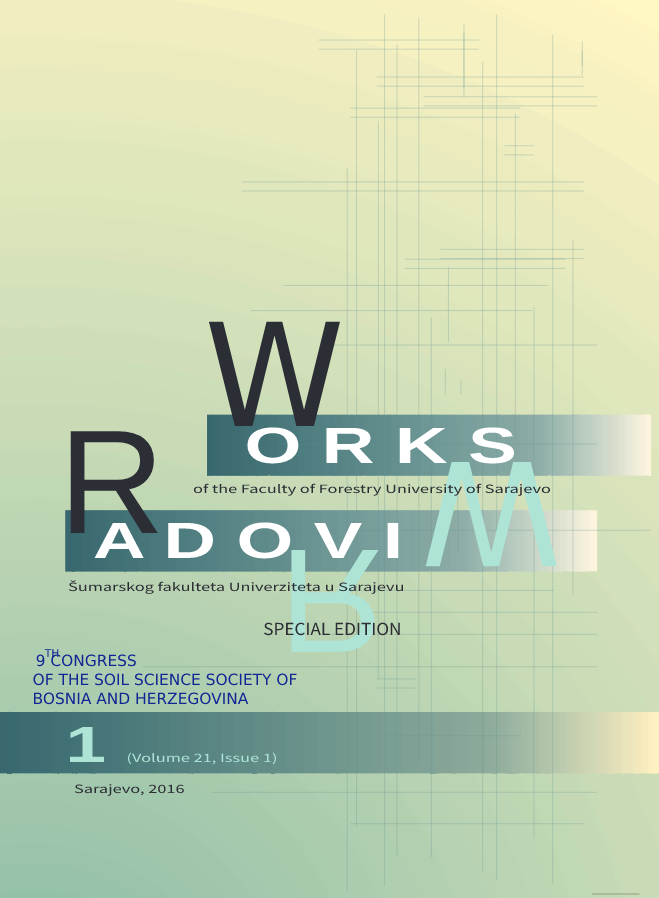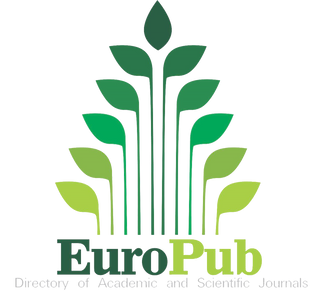MICROBIOLOGICAL PROPERTIES OF REKULTISOL UNDER DIFFERENT CULTURES AT STANARI COAL MINE
DOI:
https://doi.org/10.54652/rsf.2016.v1.i1.291Ključne riječi:
rekultisol, microbiological properties, mineral fertilizers, calcificationSažetak
UDK 631.427.1(497.6)
This paper studied the number of physiological and systematic groups of microorganisms in rekultisol under the different cultures at Stanari Coal Mine, and in variants of rekultisol where mineral fertilization and calcification were applied and in variants of rekultisol where only mineral fertilization was applied. The trial was set in the field conditions at the location of the internal part of overburden deposition site, near open pit Raskovac which is the part of Stanari coal mine. Mineral fertilizers were used as starter fertilizer and supplementary nutrition in the amount of 100-140 kg/ha of N and 40-60 kg/ha P2O5 and K2O and calcification was completed by adding 4 t/ha CaCO3. Microbiological analysis of the rekultisol determined the total number of bacteria, Azotobacter sp., ammonifiers, oligonitrophyls, actinomycetes and fungi. The aim of the research is to determine microbiological properties of rekultisol under small grains, potatoes, and grass-clover mixture at “Stanari” coal mine as well as to determine the effect of mineral fertilizers and calcification on the number of microorganisms in the rekultisol under different cultures. The total number of bacteria, oligonitrophyls, sporogenic ammonifiers, Azotobacter sp. and actinomycetes was higher in rekultisol under all of the tested cultures in the variant fertilizers + CaCO3 comparing to the variant without CaCO3, while the number of ammonifiers and fungi in rekultisol under all of the tested cultures was higher in the variant without CaCO3 in relation to the variant mineral fertilizers + CaCO3. In rekultisol under grass-clover mixture, higher total number of bacteria, oligonitrophyls and fungi was recorded in both tested variants, in relation to their number in rekultisol under potatoes and small grains. The number of actinomycetes was higher in rekultisol under potato in both variants, in relation to the number of actinomycetes in rekultisol under small grains and grass clover mixture. In rekultisol under small grains in variant mineral fertilizers + CaCO3 number of ammonifiers was the lowest (182 x 104g-1 absolutely dry soil), while the highest number of ammonifiers was recorded in rekultisol under grass-clover mixture in the variant without CaCO3 (1778 x 104g-1 absolutely dry soil). Azotobacter sp. count was lowest in rekultisol under grass clover variant without CaCO3 (68 x 102g-1 absolutely dry soil), while the highest Azotobacter sp. count was recorded in rekultisol under small grains in the variant with fertilizers + CaCO3 (123 x 102g-1 absolutely dry soil).
Downloads
References
Anderson, G. R. 1965. Ecology of Azotobacter in soil of the Palouse region I. Occurrence.
Soil Science, 86:57-65.
Anderson, J.P.E., Domasch, K.H. 1958. A physiological method for the quantitative measurement of microbial biomas in soil. Soil Boil. Biochem. 10: 215-221.
Barabasz, W., Albińska1, D., Jaśkowska, M., Lipiec, J. 2002. Biological Effects of Mineral Nitrogen Fertilization on Soil Microorganisms. Polish Journal of Environmental Studies, 11: 193-198.
Bennet, W. F. 1993. Nutrient deficiencies and toxicities in crop plants. APS Press, St.
Paul, Minnesota. Pages 202.
Bogdanović, V. 1990. Zastupljenost mikroorganizama u deponiji pepela. Zemljište i biljka, 39 (2): 139-145.
Dželetović Ž., Filipović R., Stojanović D., Vučković M., Djurdjević M., Lazarević M. 1995. Agrohemijska ispitivanja odlagališta jalovine "Petka" ugljenokopa "Đirikovac" radi rekultivacije njegove površine. Rudarski glasnik, 3-4: 23-30.
Emmerling, C., Schloter, M., Hartmann, A., Kandeler, E. 2002. Functional diversity of soil organisms-a review of recent research activities in Germany. Journal Plant Nutrient and Soil Science, 165: 408–420.
Filipović R., Kotlajić, M., Simić, S. 1981. Uticaj mineralnih djubriva na prinos nekih ratarskih kultura na zemljištima oštećenim rudarskim adovima. Zb.gozdarstva in lesarstva, 19: 273 - 290.
Golic, Z., Malic N., Raicevic, V. 2014: Presence ofDifferent Groups of Microorganisms Deposol in Reclamation at Stanari Coal Mine. Book of Proceedings – Fifth International Scientific Agricultural Symposium ''Agrosym 2014'' B&H – Jahorina, pp. 777–782.
Golić, Z., Raičević, V., Jovanović, Lj., Antić-Mladenović, S., Kiković, D. 2006. Number and activity of microorganisms in bauxite mine soil. Zemljište i biljke, 55: 203-210.
Jarak, M, Belić, M., Govedarica, M., Milošević, N., Đurić, S. 2003. Effect of phosphogypsum and peat on microbiological and chemical properties of arenosol. Zemljište i biljka, 52: 1-6.
Jarak, M., Čolo, J. 2007. Mikrobiologija zemljišta, Univerzitet u Novom Sadu, Poljoprivredni fakultet.
Jarak, M., Govedarica, M. 2003. Mikrobiologija, Univerzitet u Novom Sadu, Poljoprivredni fakultet.
Jelić, M., Đalović, I, Živanović-Katić, S. 2008. The effect of application of different systems fertilization on the changes of chemical properties of soil and grain yield of spring small grains. Proceedings Ecological Truth 2008, UB-Technical faculty in Bor, Serbia, pp. 261-267.
Kourtev, P.S., Ehrenfeld, J. G. M., Häggblom, M. 2002. Exotic plant species alter the microbial community structure and function in the soil. Ecology, 83: 3152-3166.
Krasiljnikov, N.A., 1965. Biologija otedeljnih grup aktinomicetov, Nauka, Moskva.
Lončar S., Đurović M., Trbić M., Malić N. 2009.Presjek dugoročnog plana rekultivacije površinskih kopova ugljenog basena Stanari. Zbornik radova VIII međunarodne konferencije ''Nemetali 2009''. Srbija – Vrujci, pp. 126–133.
Malić, N., Matko-Stamenković, U., Nožinić, M. 2012. Tehnogena zemljišta stanarskog ugljenog basena u funkciji ekološkog i poljoprivrednog resursa. Zbornik radova Međunarodnog kongresa ekologa ''Ekološki spektar 2012'' Republika Srpska – BiH, Banja Luka, Vol: 1, pp. 651–669.
Resulović, H. 1982. Neke specifičnosti procesa pedodinamike i pedogeneze u deposolima. Zemljište i biljka, 31: 357 - 363.
Sheoran, V, Sheoran, A.S., Poonia, P. 2010. Soil Reclamation of Abandoned Mine Land by Revegetation. International Journal of Soil, Sediment and Water, 3: 1-20.
Tabatabai, M. 1982. The role of soil enzymes in the degradation of Organic in the Tropics, Subtropics and Temperature zones. 12th International Congress of Soil Science, New Delhy.
Tintor, B., Milošević, N., Sekulić, P., Pucarević, M. 2008. Mıcrobıologıcal properties of soil in Pančevo inudstrial areas. Proceedings Ecological Truth, UB-Technical faculty in Bor, Serbia, pp. 297-301.
Tintor, B., Milošević, N., Vasin, J. 2009. Mikrobiološka svojstva černozema Južne Bačke u zavisnosti od načina korišćenja zemljišta. Zbornik radova Naučnog instituta za ratarstvo i povrtlarstvo, 46: 189-198.
Williams, S.T., Wellington, E.M.H. 1982. Principles and problems of selective isolation of microbes, in: J.D. Bullock, L.J. Nisbet, D.J. Winstanley (Eds.), Bioactive Microbial Products 1: Search and Discovery, Academic Press, UK pages 9-26.























